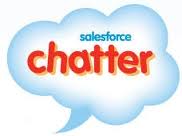Salesforce.com’s Chatter mobilises McKinsey’s strategies...
September 8, 2010
 Today during his keynote at Cloudforce 2010 in London’s Royal Festival Hall, Marc Benioff, Chairman and Chief Executive of Salesforce.com, launched Chatter Mobile to the usual adoring audience.
Today during his keynote at Cloudforce 2010 in London’s Royal Festival Hall, Marc Benioff, Chairman and Chief Executive of Salesforce.com, launched Chatter Mobile to the usual adoring audience.
Chatter Mobile extends Salesforce’s recently introduced Chatter Enterprise Collaboration system to a range of the most popular mobile devices, including the Apple iPhone and iPad, Blackberry and Android.
The Facebook paradigm adapted to Enterprise Collaboration
Chatter is best described as the Facebook paradigm adapted to Enterprise-wide collaboration. It makes it easy for employees to ask questions and share insights that help to solve problems, keep everyone on the same page and prevent duplication of effort.
It clearly has the potential to create truly collaborative communities, and to dramatically reduce unproductive email traffic. It allows participants to receive real-time updates on people, groups, sales opportunities and documents. But equally importantly, it allows them to filter what they see.
Facilitating informal structures
It’s long been recognised that companies rely on informal networks as much as they do formal structures. Researchers from McKinsey, in an April 2007 paper, recognised the role of networks in organisational change and argued that “companies shouldn’t focus so much on formal structures that they ignore the informal ones”.
McKinsey’s experts identified that a “key part of the problem is that the boxes and lines of formal organizational charts mask myriad relationships in networks that criss-cross the borders of functions, hierarchies, and business units. These networks define the way work actually gets done in today’s increasingly collaborative, knowledge-intensive companies.”
The problems with Enterprise Collaboration
The challenge has been that most technology-driven approaches to facilitating collaborations - like Lotus Notes or Microsoft Sharepoint, to take two high-profile examples - rely on outdated paradigms for creating networks and sharing information.
If Facebook were a country, it would be the world’s Third largest. It’s no surprise that Facebook’s success has been driven by the ease with which its’ “citizens” are able to make connections and share information anywhere, anyhow.
Facebook for the Enterprise
It strikes me that in Chatter, Salesforce have the potential to create the first credible Facebook for the Enterprise. But if you’re not a Facebook user - and maybe think that it’s still “something for kids” - don’t let that epithet put you off. Chatter is a deadly serious, and highly productive, business tool.
With a level of utility and immediacy that goes beyond corporate intranets or wikis, applications like Chatter could prove to be the catalyst that allows companies to realise McKinsey’s vision of the truly collaborative, knowledge-intensive company.
Benioff’s experience inside Salesforce
I was particularly interested to hear about Marc Benioff’s experiences of using Chatter inside Salesforce. As he pointed out, it made it easy to identify the natural collaborators that really solved problems and made things happen within the organisation.
As McKinsey had pointed out in their report a few years back, these often undocumented relationships carry much of the true value of an organisation. And now it had become easy to identify the most valuable contributors.
Impact on management and reward systems
Marc Benioff went on to explain how it had stimulated Salesforce to rethink their appraisal, compensation and reward systems. The increased visibility given to the role of these high-value collaborators is going to allow organisations to have a better understanding of the true value of the contributions made by each employee in advancing the organisation’s best interests.
So I want to leave you with a few thoughts. How are you facilitating collaboration inside your company today? Are you able to easily identify the people who are making the greatest real contribution to making things happen? Have you reflected this in your reward system? And are you doing enough to ensure that they see that their contribution is recognised and valued?


Comments